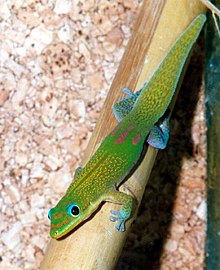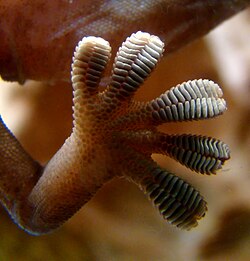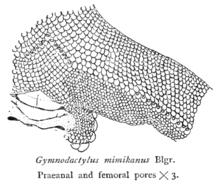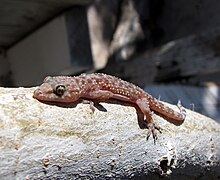Gecko
| Gecko Temporal range:
| |
|---|---|

| |
| Gold dust day gecko (also known as Madagascar day geckos) | |
| Scientific classification | |
| Kingdom: | |
| Phylum: | |
| Class: | |
| Order: | |
| Suborder: | |
| Family: | Gekkonidae Gray, 1825
|
| Subfamilies | |
|
Aeluroscalabotinae | |
Geckos are small to average sized lizards belonging to the family Gekkonidae, found in warm climates throughout the world. Geckos are unique among lizards in their vocalizations, making chirping sounds in social interactions with other geckos. An estimated 2,000 different species of geckos exist worldwide, with many likely yet to be discovered. The name stems from the Indonesian/Japanese word Tokek, inspired by the sound these animals make. The Malay word for gecko is cicak.
All geckos, excluding the Eublepharinae family, have no eyelids and instead have a transparent membrane which they lick to clean. Many species will, in defense, expel a foul-smelling material and feces onto their aggressors. There are also many species that will drop their tails in defense, a process called autotomy. Many species are well known for their specialized toe pads that enable them to climb smooth and vertical surfaces, and even cross indoor ceilings with ease (it is believed that the van der Waals force may contribute to this capability). These antics are well-known to people who live in warm regions of the world, where several species of geckos make their home inside human habitations. These species (for example the House Gecko) become part of the indoor menagerie and are often welcome guests, as they feed on insects, including mosquitoes.
The largest species, Delcourt's gecko, is only known from a single, stuffed specimen found in the basement of a museum in Marseille, France. This gecko was 60 cm long and it was native to New Zealand. It was probably wiped out along with much of the native fauna of these islands at the end of the 19th century, when new predators were introduced there. The smallest gecko, the Jaragua Sphaero, is a mere 16 mm long and was discovered in 2001 on a small island off the coast of the Dominican Republic.[2]
Common traits
Geckos come in various colors and patterns such as purple, pink, and blue. . Some are subtly patterned and somewhat rubbery looking, while others are brightly colored. Some species can change color to blend in with their environment or with particular temperatures. Some species are parthenogenic, which means the female is capable of reproducing without copulating with a male. This improves the gecko's ability to spread to new islands. However, in a situation where a single female gecko populates an entire island, said island will suffer from a lack of genetic variation within the geckos that inhabit it. The Gecko's mating call sounds like a shortened bird chirping which attracts males when they are around so the female can create a baby with more genetic variation by using sexual reproduction instead of asexual. Geckos also make a quality pet for small households. They can live and breed in small tanks or Terrariums. They must have proper living space to survive. The average temperature in the day should be between 78-88 degrees Fahrenheit (25-31 degrees Celsius) and at night temperatures should not go below 72 degrees Fahrenheit (22 degrees Celsius) inside the tank. Proper foods for the geckos range from small baby crickets, roaches, phoenix worms and manufactured diets such as crested gecko diet. Many have a sweet tooth and like fresh fruits and honey. [3]
Gecko toes: setae and van der Waals forces

The toes of the gecko have a special adaptation that allows them to adhere to most surfaces without the use of liquids or surface tension. Recent studies of the spatula tipped setae on gecko footpads demonstrate that the attractive forces that hold geckos to surfaces are van der Waals interactions between the finely divided setae and the surfaces themselves. Every square millimetre of a gecko's footpad contains about 14,000 hair-like setae. Each seta has a diameter of 5 microns. Human hair varies from 18 to 180 microns, so a human hair could hold between 3 and 36 setae. Each seta is in turn tipped with between 100 and 1,000 spatulae.[4] Each spatula is 0.2 microns long[4] (200 billionths of a metre), or just below the wavelength of visible light.[5]

These van der Waals interactions involve no fluids; in theory, a boot made of synthetic setae would adhere as easily to the surface of the International Space Station as it would to a living room wall, although adhesion varies with humidity and is dramatically reduced under water, suggesting a contribution from capillarity.[6] The setae on the feet of geckos are also self cleaning and will usually remove any clogging dirt within a few steps.[4][7] Teflon, which has very low van der Waals forces,[8] is the only known surface to which a gecko cannot stick.[9] Geckos' toes seem to be "double jointed", but this is a misnomer. Their toes actually bend in the opposite direction from our fingers and toes. This allows them to overcome the van der Waals force by peeling their toes off surfaces from the tips inward. In essence, this peeling action alters the angle of incidence between millions of individual setae and the surface, reducing the Van der Waals force. Geckos' toes operate well below their full attractive capabilities for most of the time. This is because there is a great margin for error depending upon the roughness of the surface, and therefore the number of setae in contact with that surface. If a typical mature 70 g (2.5 oz) gecko had every one of its setae in contact with a surface, it would be capable of holding aloft a weight of 133 kg (293 lb):[10] each spatula can exert an adhesive force of 10 nanonewtons (0.0010 mgf).[6] Each seta can resist 10 milligrams-force (98 μN), which is equivalent to 10 atmospheres of pull.[4]. This means a gecko can support about eight times its weight hanging from just one toe on smooth glass. [4]
Nocturnal vision
A study from Lund University[11] proved that nocturnal geckos such as the helmet gecko, Tarentola chazaliaei, discriminate colors in dim moonlight when humans are color blind. The sensitivity of the helmet gecko eye was calculated to be 350 times higher than human cone vision at the color vision threshold. The optics in the gecko's eyes, having distinct concentric zones of different refractive powers that constitute a multifocal optical system, together with the large cones of the gecko, are important reasons why they can use color vision at low light intensities. Although the intraspecific variation is large, in most of the individuals studied the concentric zones differed by 15 diopters. This is of the same magnitude as needed to focus light of the wavelength range to which gecko photoreceptors are most sensitive. In contrast, the optical system of a different day gecko species showed no signs of distinct concentric zones and is thereby monofocal. Another feature of the nocturnal geckos – and other lizards – in which they differ from most other vertebrates is that they only have cones in their retina.
Taxonomy
The Family Gekkonidae is divided into five subfamilies, containing numerous genera of gecko species.
Classification

Family Gekkonidae
- Subfamily Aeluroscalabotinae
- Single Genus Aeluroscalabotes, only one Species A. felinus, Southeast Asia
- Subfamily Diplodactylinae
- 16 genera, found in Oceania
- Subfamily Eublepharinae
- 5 genera
- Subfamily Gekkoninae
- Biggest subfamily, with 74 genera worldwide, some of the biggest genera are:
- Genus Gehyra, Web-toed Geckos or Dtellas
- Genus Gekko, true geckos
- Genus Hemidactylus
- Genus Phelsuma, day geckos, most are endemic to Madagascar.
- Genus Phyllodactylus, leaf-toed geckos
- ...
- Biggest subfamily, with 74 genera worldwide, some of the biggest genera are:
- Subfamily Teratoscincinae
- Single Genus Teratoscincus (7 species)
Common species of geckos


- Pachydactylus, Genus of Geckos of which there are many species.
- Bibron's gecko, Pachydactylus bibroni — Native to Southern Africa, this hardy arboreal gecko is considered a household pest.
- Crocodile gecko or Moorish gecko, Tarentola mauritanica — very strong and heavily built for their size usually growing up to 15 cm (6 in). They are commonly found in the Mediterranean region from the Iberian Peninsula and southern France to Greece and northern Africa. Their most distinguishing characteristic is their pointed head and spiked skin with their tail resembling that of a crocodile's.
- Cyrtopodion, Genus of Geckos of which there are many species.
- Cyrtopodion brachykolon; commonly known as "bent-toed gecko", found in north-western Pakistan.
- Rhacodactylus, genus of Geckos of which there are a few species.
- Suras Gecko belonging to the Genus of rhacodactylus.
- Crested gecko, Rhacodactylus ciliatus — Believed extinct until rediscovered in 1994. Gaining in popularity as a pet.
- Gargoyle gecko, Rhacodactylus auriculatus — commonly known as the New Caledonian bumpy gecko or gargoyle gecko.
- Gold dust day gecko (Phelsuma laticauda laticauda (Boettger, 1880) (syn. Pachydactylus laticauda Boettger, 1880)) is a diurnal subspecies of geckos. It lives in northern Madagascar and on the Comoros.
- Golden Gecko, Gekko ulikovskii — native to the warm rainforests of Vietnam.
- Hemidactylus, genus of geckos of which many varieties belong.
- Common House Gecko, Hemidactylus frenatus — A species that thrives around man and human habitation structures in the tropics and subtropics world wide.
- Indo-Pacific Gecko, Hemidactylus garnotii — Also known as a fox gecko because of its long, narrow snout. This species is found in houses throughout the tropics. This gecko may eat leafcutter ants.
- New Caledonian giant gecko, Rhacodactylus leachianus — first described by Cuvier in 1829, is the largest of the Rhacodactylus geckos.
- Leopard gecko, Eublepharis macularius — The most common gecko kept as a pet is the leopard gecko, which does not have toe pads with setae, but rather claws. These enable it to more easily climb on rough surfaces like tree bark. This gecko cannot climb the glass of a terrarium. The leopard gecko tends to be docile and calm. This gecko can eat butterworms, cockroaches, crickets, mealworms, waxworms, superworms, and pink mice.
- Mediterranean gecko, Hemidactylus turcicus — residential and wild, introduced species (USA).
- Mourning gecko, originally an East Asian and Pacific species, Lepidodactylus lugubris is equally at home in the wild as in residential neighborhoods. Found in Hawaii, it may have been an early Polynesian introduction. A parthenogenic species. There is a report from Hawaii of someone having seen a larger gecko of this type eating a smaller one (or rather, running away from view with a smaller gecko halfway out of its mouth) on three or more occasions.[citation needed]
- Ptychozoon, — a genus of arboreal gecko from Southeast Asia, known as Flying Geckos or Parachute Geckos, has wing-like flaps from the neck to the upper leg, to help it conceal itself on trees and provide lift while jumping.
- Stump-toed gecko, Gehyra mutilata (Peropus mutilatus) — This gecko, commonly referred to as a Gheckl, can vary its color from very light to very dark to blend into a background. At home in the wild as well as in residential neighborhoods.
- Tree gecko, Hemiphyllodactylus typus — Tree geckos are forest dwellers.
- Tokay gecko, Gekko gecko — a large, common, Southeast Asian gecko known for its aggressive temperament, loud mating calls, and bright markings.
- Western banded gecko, Coleonyx variegatus — Native to southwestern United States and northwest Mexico.
- Dwarf gecko, Sphaerodactylus ariasae — native to the Caribbean islands, and the world's smallest lizard
Geckos in popular culture
Corporate symbols
- In the past few years, geckos have entered into the consciousness of the USA as the advertising icon for the insurance company GEICO, whose advertisements feature an animated anthropomorphic gecko (of the Phelsuma genus) that speaks with an English accent.
- The current mascot of SUSE Linux distributions is a Chameleon called Geeko, also known as the "SUSE Lizard".
- The logo of the car builder Wiesmann is a gecko.
- The beverage company SoBe uses a dancing gecko as a mascot.
- The logo of the poker site PokerLizard.com features a gecko.
Video games
- Gex is an anthropomorphic, wise-cracking gecko and the protagonist of the GEX series.
- The Pokémon Treecko, and its evolved forms Grovile and Sceptile are based on the gecko.
- Fallout 2 features mutated geckos as low-level enemies, with more powerful variants appearing later in the game. There is also a town called Gecko, and gecko skins can be harvested.
- Demon's Souls includes several rare monsters called Crystal Geckos, which must be killed quickly in order to obtain valuable resources used later in the game.
- Metal Gear Solid 4 features armed walking tanks called GEKKOs also nicknamed LIZARDS, similar to the gecko they drop a green liquid and produce a strong sound, they also appear climbing on walls and doing long jumps and are equipped with a special vision systems.
Literature
- A gecko called Geronimo is featured in the book My Family and Other Animals by the celebrated naturalist Gerald Durrell.
- Edgar, a character from the webcomic Pandect is an Ace of Blue and White geckos. He is possibly a piebald blue gecko.
- In the book Spud, the narrator's friend (who dies of malaria) is named Gecko (due to the fact that he's always sick).
Film and television
- The horror film Aberration featured mutated geckos.
- In the animated film Madagascar, there is a dancing Gecko used as King Julian's new crown
- The design of the Malaysian superhero Cicak Man is based on the gecko; cicak is Malay for gecko.
- In the sitcom Frasier episode The First Temptation Of Daphne, Martin and Frasier use a gecko to catch a cricket in Frasier's apartment.
- In the Geico commercial, there is a gecko representing how much money you could be saving with Geico
See also
References
- ^ Arnold, E.N., & Poinar, G. (2008). "A 100 million year old gecko with sophisticated adhesive toe pads, preserved in amber from Myanmar (abstract)" (PDF). Zootaxa. Retrieved August 12, 2009.
{{cite web}}: Unknown parameter|dateformat=ignored (help)CS1 maint: multiple names: authors list (link) - ^ Piper, Ross (2007), Extraordinary Animals: An Encyclopedia of Curious and Unusual Animals, Greenwood Press.
- ^ http://www.leopardgecko.co.uk/documents/leopard-gecko-morph.htm
- ^ a b c d e Hansen, W. R. (2005). "Evidence for self-cleaning in gecko setae". PNAS. 102 (2): 385–389. doi:10.1073/pnas.0408304102.
Setae occur in uniform arrays on overlapping lamellar pads at a density of 14,400 per mm2
{{cite journal}}: Cite has empty unknown parameter:|month=(help); Unknown parameter|coauthors=ignored (|author=suggested) (help) - ^ Autumn, Kellar (2002). "Evidence for van der Waals adhesion in gecko setae". PNAS. 99 (19): 12252–12256. doi:10.1073/pnas.192252799.
{{cite journal}}: Cite has empty unknown parameter:|month=(help); Unknown parameter|coauthors=ignored (|author=suggested) (help) - ^ a b Lee, Haeshin (2007). "A reversible wet/dry adhesive inspired by mussels and geckos". Nature. 448 (7151): 338–341. doi:10.1038/nature05968.
{{cite journal}}: Cite has empty unknown parameter:|month=(help); Unknown parameter|coauthors=ignored (|author=suggested) (help) - ^ How Geckos Stick to Walls
- ^ Why do the gecko's feet not stick to a teflon surface?
- ^ Adhesives, Anne Peattie, University of California-Berkeley.
- ^ Kellar Autumn, Scientific American: Ask the experts. Accessed 5 June 2007
- ^ Roth, Lina S. V.; Lundström, Linda; Kelber, Almut; Kröger, Ronald H. H.; Unsbo, Peter (March 30, 2009). "The pupils and optical systems of gecko eyes". Journal of Vision. 9(3):27: 1–11. doi:10.1167/9.3.27.
{{cite journal}}: CS1 maint: multiple names: authors list (link)
Further reading
- Forbes, Peter (4th Estate, London 2005) 'The Gecko's Foot - Bio Inspiration: Engineered from Nature' ISBN 0-00-717990-1 in H/B
